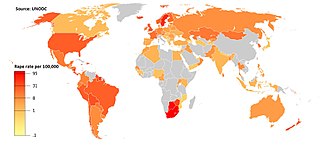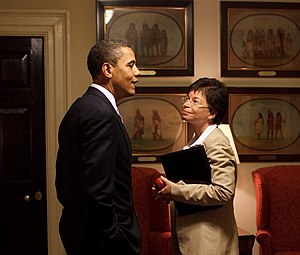
The Rape, Abuse & Incest National Network (RAINN) is an American nonprofit anti-sexual assault organization, the largest in the United States. RAINN operates the National Sexual Assault Hotline, as well as the Department of Defense (DoD) Safe Helpline, and carries out programs to prevent sexual assault, help survivors, and ensure that perpetrators are brought to justice through victim services, public education, public policy, and consulting services.

Title IX is a federal civil rights law in the United States of America that was passed as part of the Education Amendments of 1972. It prohibits sex-based discrimination in any school or other education program that receives federal money. This is Public Law No. 92‑318, 86 Stat. 235, codified at 20 U.S.C. §§ 1681–1688. The early legislative draft was authored by Representative Patsy Mink with the assistance of Representative Edith Green. It was then co-authored and introduced to Congress by Senator Birch Bayh in the U.S. Senate, and Congresswoman Patsy Mink in the House. It was later renamed the Patsy T. Mink Equal Opportunity in Education Act following Mink's death in 2002.
Sexual assault is an act in which a person intentionally sexually touches another person without that person's consent, or coerces or physically forces a person to engage in a sexual act against their will. It is a form of sexual violence, which includes child sexual abuse, groping, rape, or the torture of the person in a sexual manner.
Prison rape commonly refers to the rape of inmates in prison by other inmates or prison staff. In 2001, Human Rights Watch estimated that at least 4.3 million inmates had been raped while incarcerated in the United States. A United States Department of Justice report, Sexual Victimization in Prisons and Jails Reported by Inmates, states that "In 2011–12, an estimated 4.0% of state and federal prison inmates and 3.2% of jail inmates reported experiencing one or more incidents of sexual victimization by another inmate or facility staff in the past 12 months or since admission to the facility, if less than 12 months." However, advocates dispute the accuracy of the numbers, saying they seem to under-report the real numbers of sexual assaults in prison, especially among juveniles.

Sexual assault in the United States armed forces is an ongoing issue which has received extensive media coverage in the past. A 2012 Pentagon survey found that approximately 26,000 women and men were sexually assaulted that year; of those, only 3,374 cases were reported. In 2013, a new Pentagon report found that 5,061 troops reported cases of assault. Some are optimistic that this increase in reports is indicative of victims "growing more comfortable in the system". Of the reported cases, only 484 cases went to trial; 376 resulted in convictions. Another investigation found that one in five women in the United States Air Force who were sexually assaulted by service members reported it, for one in 15 men.

Rape culture is a sociological theory of a setting in which rape is pervasive and normalized due to societal attitudes about gender and sexuality. Behaviors commonly associated with rape culture include victim blaming, slut-shaming, sexual objectification, trivializing rape, denial of widespread rape, refusing to acknowledge the harm caused by sexual violence, or some combination of these. It has been used to describe and explain behavior within social groups, including prison rape and in conflict areas where war rape is used as psychological warfare. Entire societies have been alleged to be rape cultures. It is associated with rape fantasy and rape pornography.

The Violence Against Women Act of 1994 (VAWA) was a United States federal law signed by President Bill Clinton on September 13, 1994. The Act provided $1.6 billion toward investigation and prosecution of violent crimes against women, imposed automatic and mandatory restitution on those convicted, and allowed civil redress when prosecutors chose to not prosecute cases. The Act also established the Office on Violence Against Women within the Department of Justice.
The Office for Civil Rights (OCR) is a sub-agency of the U.S. Department of Education that is primarily focused on enforcing civil rights laws prohibiting schools from engaging in discrimination on the basis of race, color, national origin, sex, disability, age, or membership in patriotic youth organizations.
Statistics on rape and other sexual assaults are commonly available in industrialized countries, and are becoming better documented throughout the world. Inconsistent definitions of rape, different rates of reporting, recording, prosecution and conviction for rape create controversial statistical disparities, and lead to accusations that many rape statistics are unreliable or misleading. In some jurisdictions, male-female rape is the only form of rape counted in the statistics. Countries may not define forced sex on a spouse as "rape". Rape is an under-reported crime. Prevalence of reasons for not reporting rape differ across countries. They may include fear of retaliation, uncertainty about whether a crime was committed or if the offender intended harm, not wanting others to know about the rape, not wanting the offender to get in trouble, fear of prosecution, and doubt in local law enforcement.
The White House Council on Women and Girls was an advisory council within the Office of Intergovernmental Affairs of the Executive Office of the President of the United States. It was established by Executive Order 13506 on March 11, 2009, with a broad mandate to advise the president on issues relating to the welfare of women and girls in order to ensure gender equality. It also ensured that other White House agencies acted in a manner to allow all things to be possible for all people. The Council was chaired by Valerie Jarrett and included the heads of every federal agency and major White House office.
Rape in the United States is defined by the Department of Justice as "Penetration, no matter how slight, of the vagina or anus with any body part or object, or oral penetration by a sex organ of another person, without the consent of the victim." While definitions and terminology of rape vary by jurisdiction in the United States, the FBI revised its definition to eliminate a requirement that the crime involve an element of force.
Campus sexual assault is the sexual assault, including rape, of a student while attending an institution of higher learning, such as a college or university. The victims of such assaults are more likely to be female, but any gender can be victimized. Estimates of sexual assault, which vary based on definitions and methodology, generally find that somewhere between 19 and 27% of college women and 6–8% of college men are sexually assaulted during their time in college. In 2007, 23 psychologists conducted a study in which 47% of women in the United States have been sexually assaulted or raped in the past year. This was very beneficial to many other researchers in the same field.
Andrea Lynn Pino is an American women's rights and civil rights activist, author, and a public scholar on issues of global gender based violence, media framing of violence, gender and sexuality, and narratives of survivorhood. She is the queer daughter of Cuban refugees and a survivor of sexual assault.
Mary P. Koss is an American Regents' Professor at the University of Arizona, Mel and Enid Zuckerman College of Public Health in Tucson, Arizona. Her best known works have been in the areas of gender-based violence and restorative justice.
Families Advocating for Campus Equality (FACE) is an American advocacy group whose stated goal is to ensure fairness and due process for all parties involved in allegations of sexual misconduct on college and university campuses. FACE was started by Sherry Warner Seefeld and two other mothers who say their sons were falsely accused of sexual misconduct on their college campuses.
The ARC3 Survey is a campus climate survey developed to assess perpetration and victimization of sexual misconduct on college campuses in the United States. In addition to measuring rates of sexual assault on campus, the survey also gathers data on those who are engaging in sexual assault. It was developed by a group of sexual assault researchers and student affairs professionals in response to the White House Task Force to Protect Students from Sexual Assault. The survey is free for college campuses to use. The study has been used to assess both graduate and undergraduate students.

The United State of Women Summit was a summit held in Washington, D.C. focused on gender equality in the United States. The summit was hosted by the White House, the U.S. Department of State, the U.S. Department of Labor, and the Aspen Institute.
After a sexual assault or rape, victims are often subjected to scrutiny and, in some cases, mistreatment. Victims undergo medical examinations and are interviewed by police. If there is a criminal trial, victims suffer a loss of privacy and their credibility may be challenged. Victims may also become the target of slut-shaming, abuse, social stigmatization, sexual slurs and cyberbullying.
Research consistently shows that the majority of rape and other sexual assault victims do not report their attacks to law enforcement. Reasons for not reporting include fear of reprisal, shame, uncertainty about whether a crime was committed, or a belief that an incident was not sufficiently serious enough to report. As a result, researchers generally rely on surveys to measure sexual violence that is not reported to the police. Estimates of campus sexual assault measured on surveys vary across populations and over time, however a recent review concluded that a "reasonable average" of around 1 in 5 (20%) of women were sexually assaulted during their time in college. And although much of the research on sexual assault has focused on college campuses, there is evidence that non-students of the same age are actually at higher risk than college students.







